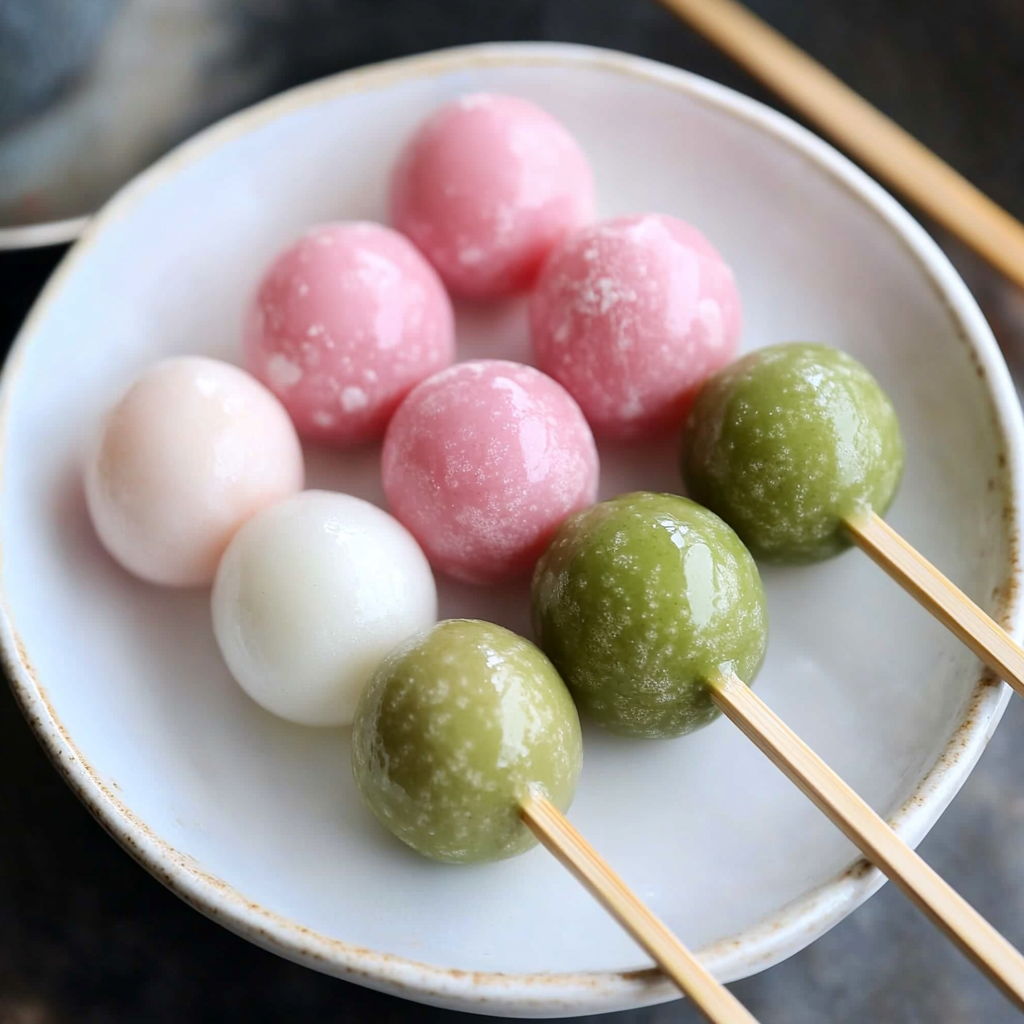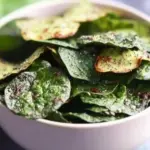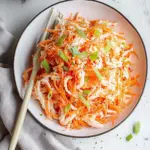The vibrant colors and chewy texture of Hanami Dango make it a delightful Japanese treat that’s traditionally enjoyed during cherry blossom season. Made from glutinous rice flour and lightly sweetened, these dumplings are naturally dyed in pink, white, and green and served on skewers — a stunning visual and cultural treat!
This easy homemade version brings a taste of Japan’s springtime to your kitchen. Whether you’re celebrating Hanami or just looking for a unique dessert, Hanami Dango is the perfect mix of simple, pretty, and nostalgic. The soft chew, gentle sweetness, and festive presentation make it a hit for kids and adults alike.
Full Recipe
Ingredients:
-
1 cup glutinous rice flour (shiratamako or mochiko)
-
2 tbsp sugar
-
1/2 cup warm water
-
Natural food coloring (pink and green)
-
Water for boiling
-
Cold water (for rinsing cooked dango)
-
Bamboo skewers
Directions:
-
In a large bowl, combine glutinous rice flour and sugar.
-
Gradually add warm water while mixing until a soft, pliable dough forms. It should not be too sticky or dry.
-
Divide the dough into three equal parts. Leave one part white, add a drop or two of pink coloring to the second part, and green coloring to the third. Mix each portion until evenly colored.
-
Roll each color into 6 equal balls (18 total).
-
Bring a large pot of water to a gentle boil. Drop the balls in carefully. When they float to the top, boil for 1-2 more minutes.
-
Use a slotted spoon to transfer cooked dango into a bowl of cold water to stop cooking.
-
Thread three dango balls (one of each color) onto bamboo skewers in this order: pink, white, green.
-
Serve at room temperature and enjoy during springtime or festive occasions!
Prep Time: 15 minutes | Cooking Time: 10 minutes | Total Time: 25 minutes
Kcal: 120 kcal | Servings: 6 skewers
The Cultural Significance of Hanami Dango
Hanami Dango is more than just a sweet treat—it’s a symbol of Japan’s cherished cherry blossom season. “Hanami” translates to “flower viewing,” referring specifically to the custom of enjoying the transient beauty of cherry blossoms, or “sakura.” During this season, families, friends, and coworkers gather under blooming cherry trees to celebrate spring, share meals, and reflect on the fleeting nature of life. One of the signature foods at these gatherings is Hanami Dango, a traditional Japanese sweet that embodies the spirit and colors of the season.
This tri-colored rice dumpling on a skewer is as meaningful as it is beautiful. Each of the three colors—pink, white, and green—holds symbolic significance. Pink represents the blossoms themselves, white stands for the last remnants of winter, and green signifies the new life and growth of spring. Eating Hanami Dango during cherry blossom season is a practice deeply rooted in centuries of Japanese tradition.
What Makes Hanami Dango Unique
Unlike other types of dango that are served hot, grilled, or with sauces like sweet soy glaze (mitarashi), Hanami Dango is simple and served at room temperature. It’s lightly sweetened, soft yet chewy, and delightfully subtle in flavor. The focus of this treat isn’t just taste—it’s texture, visual appeal, and cultural resonance.
Made from glutinous rice flour, Hanami Dango has that iconic mochi-like chewiness that fans of Japanese desserts love. However, it’s firmer and more structured than mochi, making it ideal for skewering. The colors are often achieved using natural food colorings, including beet powder for pink and matcha (green tea powder) for green, staying true to Japan’s emphasis on natural ingredients and aesthetics.
Historical Background
Dango has been part of Japanese culinary tradition for centuries, with its roots tracing back to the Heian period (794–1185). Originally offered at temples during religious rituals, dango became popular as a street food and dessert over time. Hanami Dango specifically gained popularity during the Edo period (1603–1868), especially among people attending cherry blossom festivals in places like Kyoto and Tokyo.
Even today, the dish is often sold by vendors at parks during the blooming season. Its popularity is not just due to its taste but its nostalgic association with spring, childhood, and community gatherings. For many Japanese families, making and eating Hanami Dango is a yearly tradition passed down through generations.
Occasions to Serve Hanami Dango
While traditionally served during the cherry blossom season, Hanami Dango can also be a stunning addition to other celebrations. It’s perfect for spring-themed parties, baby showers, or cultural celebrations. Its soft pastel colors make it an eye-catching centerpiece at any dessert table. And because it’s naturally gluten-free and dairy-free, it appeals to a wide range of dietary needs.
It also makes a fantastic homemade gift. Wrapped in parchment and tied with a ribbon, a few dango skewers can make a thoughtful and elegant seasonal present. If you’re hosting a Japanese-themed event or just want to experience a piece of Japan’s seasonal traditions, Hanami Dango is a must-try.
Health Considerations and Ingredients
One reason Hanami Dango remains a popular dessert is its simplicity. The main ingredient, glutinous rice flour, is high in carbohydrates and low in fat. While the dessert is sweetened, it is not overly sugary like many Western confections. This makes it a lighter option for those who want a touch of sweetness without overwhelming richness.
If you’re looking for a plant-based or gluten-free dessert, Hanami Dango checks all the boxes. It contains no dairy, no eggs, and no wheat. You can also use natural food coloring for a more health-conscious version, like matcha for green and beet juice for pink, avoiding artificial additives.
Modern Takes on a Classic Treat
Modern chefs and food enthusiasts have started giving Hanami Dango a creative twist. Some add subtle flavorings to the dough—like vanilla, strawberry essence, or yuzu zest—to enhance the experience. Others experiment with fillings, inserting sweet red bean paste inside the dumplings for an extra layer of texture and flavor.
Additionally, creative plating techniques and alternative skewering styles are becoming popular on social media, where Hanami Dango has seen a resurgence. Think mini versions, flower-shaped molds, or gold leaf accents for a luxurious finish. These modern versions retain the spirit of the original dish while giving it contemporary flair.
Tips for Perfect Hanami Dango at Home
Making Hanami Dango at home is surprisingly straightforward, but there are a few tips to help you get the best results:
-
Use the right flour: Stick to shiratamako or mochiko—these glutinous rice flours produce the correct chewy texture.
-
Achieve uniform sizes: Roll the dumplings into equal sizes to ensure they cook evenly and look appealing on the skewer.
-
Don’t overcook: Once the dumplings float, give them just a minute or two more to prevent them from becoming too soft.
-
Cool in cold water: This stops the cooking and gives the dango a pleasant, slightly bouncy texture.
-
Assemble after cooling: Thread the dumplings onto skewers only after they’ve cooled completely to maintain their shape.
These steps ensure the texture and visual integrity of the dango, which are just as important as the taste in Japanese desserts.
How to Store and Serve Hanami Dango
Hanami Dango is best enjoyed fresh, but you can also store it in an airtight container at room temperature for up to a day. If you want to keep it longer, refrigerate it—but be aware that refrigeration may alter the texture slightly, making the dumplings firmer than intended. Avoid freezing, as this tends to break down the mochi texture completely.
To serve, simply place the skewers on a decorative tray or plate. You can also sprinkle them lightly with kinako (roasted soybean flour) or serve alongside a cup of hot matcha tea for a truly traditional Japanese experience. Presentation matters, so choose a minimal, elegant layout that complements the natural beauty of the dango.
Why Hanami Dango Is Worth Making
Making Hanami Dango from scratch is a rewarding and culturally enriching experience. Unlike store-bought versions, homemade dango allows you to control sweetness, coloring, and freshness. It’s also a great hands-on activity to share with family or friends, especially children who enjoy shaping and coloring the dumplings.
Beyond its aesthetic appeal, Hanami Dango offers a moment of connection—with nature, with tradition, and with loved ones. It invites us to slow down, appreciate the season, and celebrate beauty in simplicity. In a world of fast-paced living and complex desserts, this humble trio of dumplings on a stick stands out for its elegance and emotional resonance.
Conclusion
Hanami Dango is far more than a pretty dessert—it’s a cultural icon, a seasonal ritual, and a culinary treasure. From its symbolic tri-color palette to its chewy texture and light sweetness, it captures the heart of spring in Japan. Whether you’re celebrating Hanami or just curious about Japanese cuisine, making Hanami Dango at home is a rewarding way to experience one of Japan’s most beloved traditions.
This treat isn’t just about flavor; it’s about storytelling, connection, and celebration. And the best part? You don’t need to be in Japan to enjoy it. With just a few simple ingredients and a little creativity, you can bring the beauty and flavor of Hanami season into your own kitchen.






